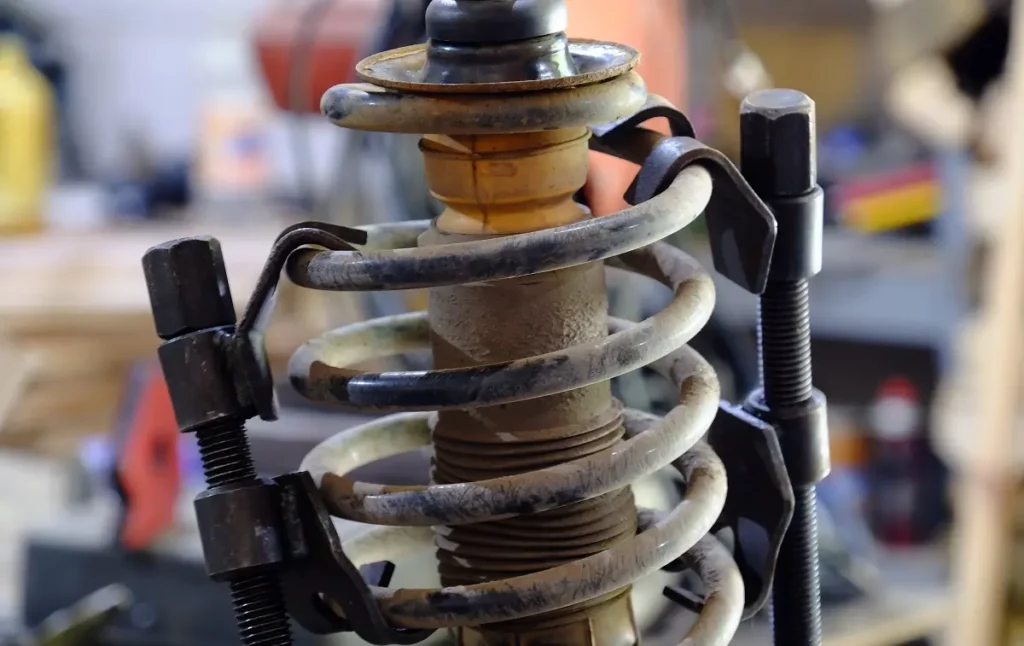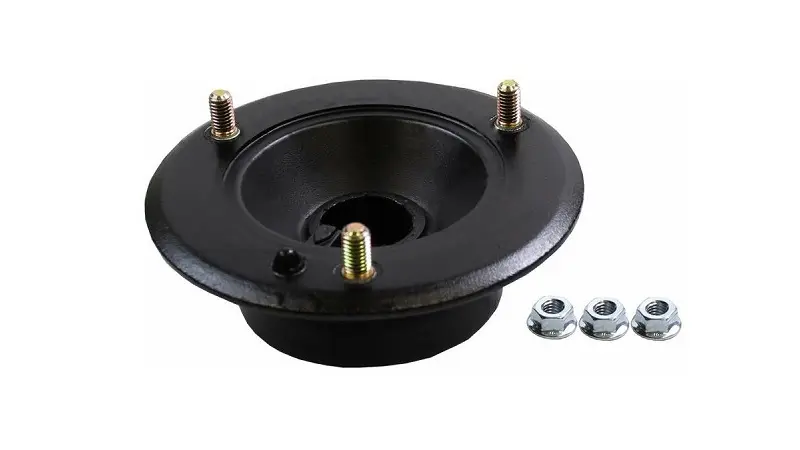The BMW E90 is by far one of the most popular 3-series models out there. Despite being considered one of the more reliable BMWs to hit the streets in recent decades, the E90 suffers from a few common issues.
The one we’ll be focusing on today is the front strut mount failure which is a common problem on these cars. In this guide, you’ll find out why this happens, how to tell if you have failing strut mounts, and what you can do to fix this issue at home.

What Is a Strut Mount?
The strut mount is a crucial component of a vehicle’s suspension system, and its purpose is to provide a secure and stable connection between the suspension strut and the vehicle’s body. The suspension strut, also known as a shock absorber, is responsible for dampening the vibrations and movements of the wheels as the vehicle moves over uneven surfaces. The strut mount acts as a buffer, absorbing some of the shocks and vibrations generated by the suspension strut, thereby preventing them from transferring to the rest of the vehicle’s body.
The strut mount also provides a pivot point for the suspension strut, allowing it to move up and down as the wheels encounter bumps and irregularities on the road. This movement is essential for maintaining a smooth ride and ensuring that the vehicle’s wheels maintain proper contact with the road surface at all times.
Over time, the strut mount can become worn or damaged, leading to increased vibration and noise in the vehicle, as well as decreased handling and stability. It is essential to have the strut mount checked and replaced as needed to ensure that the suspension system continues to function correctly and that the vehicle remains safe to drive.
Why Do Strut Mounts Fail on BMW E90?
There are several factors that can contribute to strut mount issues on a BMW E90. One of the most common causes is wear and tear over time. The strut mount is subject to constant stress and strain as the vehicle is driven, and eventually, it can become worn or damaged, leading to increased noise, vibration, and handling issues.
Another common cause of strut mount issues on a BMW E90 is exposure to the elements. Moisture, salt, and other environmental factors can cause corrosion and rust to form on the mount, leading to weakened metal and eventually structural failure.
Additionally, if the suspension system on a BMW E90 is lowered or modified for performance purposes, it can put additional stress on the strut mount and lead to premature wear and failure.
Finally, improper installation or maintenance of the strut mount can also contribute to issues. If the mount is not installed correctly or is not properly torqued, it can lead to premature wear and damage. If you need quality strut mounts, check our store! We offer strut mounts made by some of the most reputable brands in the industry, and we offer them at prices that are hard to beat!
Symptoms of a Failing or Failed Strut Mount
The strut mount is an essential component of a BMW E90’s suspension system, and if it fails, it can lead to a host of problems. Here are some of the most common symptoms of strut mount failure on a BMW e90:
Clunking or Banging Noise From the Front Suspension
One of the most common signs of a failing strut mount is a clunking or banging noise coming from the front suspension of the vehicle. This noise is typically heard when driving over bumps or rough roads and is caused by the strut mount separating from the strut itself. The noise can also be caused by a worn-out bearing inside the strut mount.
Vibration or Shimmying In the Steering Wheel
Another symptom of strut mount failure is vibration or shimmying in the steering wheel. This occurs when the strut mount is no longer able to properly secure the strut, causing it to vibrate or move excessively. As a result, the vibration is transmitted through the steering wheel and can make it difficult to control the vehicle.
Uneven Tire Wear
If the strut mount is not functioning correctly, it can cause uneven tire wear. This occurs when the suspension system is not able to properly absorb shocks and vibrations, leading to increased wear and tear on the tires.
Reduced Handling and Stability
A failing strut mount can also lead to reduced handling and stability on the road. This occurs because the strut mount is no longer able to properly secure the strut, causing it to move or wobble while driving. This can make it difficult to control the vehicle, especially at high speeds or during turns.
Leaking Strut Fluid
If the strut mount is damaged or worn out, it can cause the strut to leak fluid. This is typically seen as a small puddle of fluid under the vehicle and can cause the strut to fail completely if not addressed.
How to Fix a Worn or Failed Strut Mount?

Fixing a worn strut mount is a relatively straightforward job, albeit a dangerous one. You will need to remove the strut, then disassemble the strut mount. It’s imperative that you use quality coil spring compression tools for this job.
Depending on the type of strut you have, you may need to compress the spring a lot more than you would on other cars. This places a tremendous amount of kinetic energy between the claws of the coil compression tool. Here is a general guide on how to remove a strut on a BMW E90:
Lift the Vehicle
The first step is to safely lift the BMW E90 using a floor jack and jack stands. Make sure to follow all safety precautions and ensure that the vehicle is secure before beginning work. Remove the wheel and set it aside.
Remove the Sway Bar End Link Bracket
Before you can remove the strut, you need to remove the sway bar end link bracket that also supports the brake line. Make sure to hold the nut on the other end of the bolt, as it will spin in place.
Remove the Strut From the Hub Assembly
Using a socket wrench, remove the bolts connecting the strut to the hub assembly. Depending on the specific model and year of your BMW E90, there may be two or three bolts holding the strut in place. Once the bolts are removed, the strut can be pulled away from the hub assembly.
Remove the Strut From the Top Mount
Next, locate the top of the strut under the hood of the vehicle. The strut mount is typically held in place with three bolts or nuts. Remove these bolts or nuts and carefully remove the strut from the top mount.
Replace the Strut Mount
This is where things get a tiny bit dangerous, so only attempt this if you have the right tools and know-how. You’ll need to compress the spring before you undo the strut mount bolt. If you’re using OE Sachs shocks that have the built-in bump stop, you’ll have to compress the spring very tightly.
This means that you’ll most likely have to use a torque gun since compressing the spring by hand can be extremely difficult. With the spring compressed, undo the main bolt that holds the mount in place, and replace it with the new unit.
Reinstall the strut
To reinstall the strut, follow the same steps in reverse order. Carefully align the strut with the top mount and secure it in place with the bolts or nuts. Depending on which mount you got, there will be an arrow pointing to a small nipple. That nipple has a corresponding hole that is right next to the strut brace. Then, align the strut with the hub assembly and reattach the bolts.
Lower the Vehicle
Once the strut is securely in place, lower the vehicle back to the ground and test the suspension to ensure that everything is working correctly.
Get Quality Strut Mounts and Suspension Components at Bimmers.com
Here at Bimmers.com, we offer a wide range of quality strut mounts for the BMW E90 and many other BMW models. You’ll find genuine, OEM, and quality aftermarket parts in our catalog. Head over to our shop section, select your vehicle, and we’ll show you parts that are a guaranteed fit for your car!





